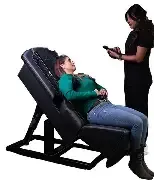
Why Decompression Feels So Good—And Works So Well
If you’ve ever finished a decompression session and thought, “Wow… I didn’t know my spine could feel this light”—you’re not imagining it.
Spinal decompression doesn’t just feel amazing—it also delivers real, measurable relief.
But why?
What’s actually happening during decompression therapy that makes such a big difference, especially for chronic back, neck, and disc pain?
Let’s break it down in simple terms.
What Is Spinal Decompression?
Spinal decompression therapy uses a specialized table that gently stretches and relaxes your spine in a controlled, rhythmic pattern.
It’s not an inversion table or a “crack and pop” adjustment.
Instead, it’s a targeted therapy designed to reduce pressure inside the spinal discs, allowing them to rehydrate, heal, and shift back into proper alignment.
When you lie on a decompression table, you’re giving your spine something it rarely gets: relief from gravity and pressure.
Here’s what happens during a session:
The table gently stretches the spine, creating negative pressure in the discs.
This “vacuum effect” helps pull bulging or herniated material back toward the center of the disc.
At the same time, the discs begin to draw in fluids, nutrients, and oxygen—all critical for healing.
Pressure on the nerves is relieved. Blood flow improves. Muscles relax.
That’s why people often say:
“It’s like my spine can finally breathe again.”
And with consistent treatment, the effects aren’t just temporary—they're corrective.
🚫 The Problem: Compression = Pain
Life compresses us. Sitting for hours, poor posture, aging, injuries, or even repetitive movements at work all take a toll.
Over time, spinal discs (those cushiony pads between your vertebrae) get:
Flattened
Dehydrated
Bulging or herniated
Pressed against spinal nerves
And that’s where the pain comes from.
Whether it's sciatica, pinched nerves, numbness in the arms or legs, or just that deep, aching back pain—it often traces back to disc pressure and nerve irritation.
💡 Why It Feels So Good
Decompression stimulates the parasympathetic nervous system—the “rest and relax” mode your body rarely gets to stay in.
That’s why you may feel:
Deep relaxation during the session
Less tightness in the low back or neck
Improved range of motion
A calm, even sleepy feeling afterward
This isn’t just comfort—it’s a signal that your nervous system is finally letting go of long-held tension and inflammation.
🧠 Long-Term Benefits We See in the Clinic
When patients commit to a personalized decompression plan, we often see:
Reduction or elimination of chronic disc pain
Decreased numbness, tingling, or shooting pain in the limbs
Fewer flare-ups with movement
Better posture and core stability
Avoidance of unnecessary surgery
And the best part? It’s non-invasive, drug-free, and incredibly safe.
You don’t have to live with constant pressure and pain. Let your spine breathe, decompress, and heal—one gentle session at a time.

📚 References
Apfel, Corey C., et al. “Prospective, Randomized, Controlled Study of the Efficacy of Spinal Decompression via Motorized Traction for Chronic Discogenic Low Back Pain.” Pain Practice, vol. 8, no. 1, 2008, pp. 11–17. https://doi.org/10.1111/j.1533-2500.2007.00159.x
→ Supports: Decompression therapy’s ability to relieve disc pressure and reduce chronic back pain symptoms.Ramos, Gerard, and Howard Martin. “Effects of Vertebral Axial Decompression on Intradiscal Pressure.” Journal of Neurosurgery, vol. 81, no. 3, 1994, pp. 350–353. https://doi.org/10.3171/jns.1994.81.3.0350
→ Supports: How decompression creates negative pressure in spinal discs, promoting retraction of herniated material.Cevik, Cenk, et al. “Effectiveness of Lumbar Traction in Subacute and Chronic Low Back Pain: A Randomized, Controlled Trial.” Clinical Rehabilitation, vol. 21, no. 9, 2007, pp. 860–869. https://doi.org/10.1177/0269215507079095
→ Supports: Traction-based decompression reduces symptoms and improves function in chronic low back pain.Shealy, Norman, and Merrill M. Borgmeyer. “Decompression, Reduction, and Stabilization of the Lumbar Spine: A Cost-Effective Treatment for Lumbosacral Pain.” American Journal of Pain Management, vol. 7, no. 2, 1997, pp. 63–65.
→ Supports: Long-term improvements in discogenic pain without surgery or medication.Institute for Functional Medicine. Neurostructural and Pain Recovery Strategies. The Institute for Functional Medicine, 2021.https://www.ifm.org
→ Supports: The role of spinal decompression in activating the parasympathetic nervous system and reducing systemic tension.
